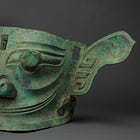Zheng Qian, Zhou Yuzhou
Name: Sun and Immortal Birds Gold Ornament
Historical Period: The Spring and Autumn Period
Diameter: 12.53 cm, Thickness: 0.02 cm, Weight: 20 g
Excavation Site: Jinsha Site, Qingyang District, Chengdu, Sichuan Province
Housed in: Jinsha Site Museum
Twelve tooth-like rotating rays are evenly distributed in the inner circle, resembling the sun spinning incessantly in the sky. Four immortal birds fly counterclockwise in the outer circle. The Sun and Immortal Birds Gold Ornament testifies to the brilliance of China's ancient Shu civilization.
Considered the acme of ancient Shu civilization, the Sun and Immortal Birds Gold Ornament captivates the world. Its exquisite craftsmanship testifies to the brilliance of ancient Shu civilization. More importantly, it unveils the cultural connection between the worship of Jin Wu (金乌, golden crow) in ancient Shu and the worship of phoenix in East Yi.
In Shu Wang Ben Ji (蜀王本纪, Biographies of the Kings of Shu), the ancient Shu Kingdom saw the reign of four states: Cancong, Baiguan, Yufu and Kaiming, each established by distinct tribes. As archaeological excavation suggests, the ancient Shu civilization underwent four stages: the Chengdu Plain Prehistoric City Site Group (Baodun site), the Sanxingdui site, the Jinsha site, and the Warring States Boat Coffin Burial site.
Solar worship of the ancient Shu Kingdom
On extremely thin gold foil are carved two-circle hollowed-out patterns. Twelve tooth-like rotating rays are evenly distributed in the inner circle, resembling the sun spinning incessantly in the sky. Four immortal birds fly counterclockwise in the outer circle. These patterns echo the cultural theme of the Bronze Divine Tree at Sanxingdui, or "Golden Crow Bearing the Sun." The myth and legend of golden crow were firstly recorded in Shan Hai Jing (山海经, The Classic of Mountains and Seas).
Some scholars observe that the Sun and Immortal Birds Gold Ornament reflects ancient Shu people's understanding of astronomy and calendar. Four immortal birds signify four seasons, and the twelve solar rays represent twelve months. The counterclockwise rotation forms a dynamic visual effect, embodying the passage of time and the cyclical nature of the seasons.
The ancient Shu and Central Plains cultural fusion
The Jinsha site, located in the west of Chengdu, 50 kilometers away from the Sanxingdui site, dates back to c. 2,600—3,200 years ago (from the late Shang Dynasty to the middle Spring and Autumn Period). More than 5,000 valuable cultural relics, such as gold, bronze, jade and lacquerware, pottery, and ivory, have been unearthed at the Jinsha site. Archaeologists infer that Jinsha probably served as the capital of ancient Shu Kingdom when the Sanxingdui civilization declined, signifying a shift in the political center.
During the mid-Warring States Period (475–221 BC), the ancient Shu engaged closely with states like Qin through marriage alliances and exchanges of wealth, tightening its cultural ties with the Central Plains. After the Qin conquered Ba and Shu, the various ethnic groups of the Shu kingdom became a significant source for the population in the southwest. Meanwhile, the Shu people scattered across other regions of the southwest integrated with the local ethnic groups.
The views don't necessarily reflect those of DeepChina.
Source: Becoming the Chinese Nation: The historical memories of multi-ethnic Chinese Nation in 100 cultural relics
Editor/ Liu Xian
Translator/ Chi Jianfeng
Related articles
Chief Editor/ Yang Xinhua
Coordination Editor/ Liu Xian
Reviewer/ Liu Li
Copyeditor/ Zhang Weiwei
Image Editor/ Tan Yujie
About DeepChina
DeepChina is an elite academic initiative that offers objective and rational analyses on a broad spectrum of topics related to China, encompassing politics, economics, culture, human rights, diplomacy, and geopolitics.






